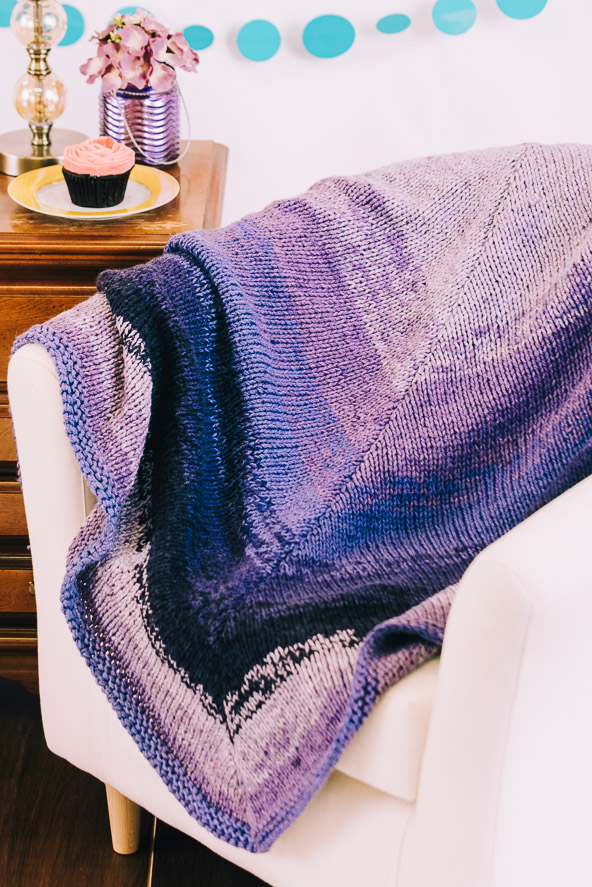
This cozy afghan uses lovely purple yarn cakes to create a pentagon-shaped design. Knit in five sections for easier handling when you knit on the road, the sections are blocked and sewn together using a single crochet seam on the back. Shaping is minimal, which makes this the perfect knit for a social evening out with your knitting buddies.
Skill Level: Beginner
Dimensions: approximately 80″ diameter at widest point; each section is approximately 39″ high x 50″ wide
Gauge: 12 sts and 16 rows = 4” [10 cm] in St st
10 sts and 14 rows = 4” [10 cm] in St st after blocking
Materials
Yarn:
![]() Caron Cakes (80% Acrylic, 20%Wool; 383 yards [350 meters]/200 grams): Bumbleberry, 10 cakes.
Caron Cakes (80% Acrylic, 20%Wool; 383 yards [350 meters]/200 grams): Bumbleberry, 10 cakes.
Needle: US size 11 (8 mm): 36” circular
Notions: Tapestry needle; US H/8 (5.0 mm) crochet hook
Abbreviations
Kfbf: Knit into the front and back and front again of next stitch – 3 sts inc’d.
Pattern Notes
Yarn is held double throughout using two yarn cakes of the same color order and batch number.
Caron Cake dye-lots are not denoted as such on the ball band. Instead, a date of manufacture and batch number can be found in the upper left corner above the bar code in the format YYYY-MM-xxxxx, where YYYY is the year, MM is the month, and xxxxx is typically a letter followed by four numbers. In the case of the sample, 2016-10-K3264 was used throughout.
If symmetry of the color stripes is important to your finished blanket, as was the case with the sample, work all triangles simultaneously one color at a time. For example, knit the first 35 rows of each triangle, lay all five out and look at the remaining yarn on each cake to ensure the stripes begin to form at the same rate.
To maintain symmetry of each triangle’s color repeat, begin each cake at the same color and do not use the first color of any cake as it may be a shorter color run which will throw off the symmetry of the pattern.
Each color repeat in a Caron Cake is specified at 63-yards however, since Caron Cakes are sold by weight the color run of the color on the outside and inside of each cake will likely not be a complete 63-yards.
When selecting skeins, be mindful of the order in which the colors appear in the cake and try to purchase all 10 cakes with the same number of color repeats and batch number. The batch number is a 5-character code which follows the year and month of manufacture above the UPC code.
Knit from the outside of each cake as there are potentially knots and uneven color runs within each skein that the knitter may elect to cut out as the pieces are worked. When this is the case, cut out the errant run of color and re-join the yarn using Russian Join with long tails, approximately 3″ each. As the yarn is predominantly acrylic, a shorter tail may work its way out of the finished piece.
If the entire piece is worked using the same amount of each color, the effect will be stripes of single colors. If the 2 cakes used at a time are off-set by 16 yards of color, as was done in the sample, the effect will become 10 tonals rather than 5 stripes.
Each triangular section has an apex angle of approximately 60 degrees. While this is technically not a mathematically perfect angle for forming a pentagon, the nature of the yarn allows it to stretch a great deal laterally as the triangle is formed and ultimately when sewn together the tension between the pieces forms the pentagon.
The single crochet seam is created 2 stitches in from the edge of each piece to incorporate the increases behind the seam and lessen their visual impact on the front of the blanket. These seams will produce a ridge on the WS, which resembles a leaded glass window. To further enhance this line, you may elect to also add a blanket stitch or whip stitch along each edge on the WS.
Stitch notes:
To minimize holes near increases, the m1r is done by inserting left needle from back to front into the horizontal strand between the last stitch worked and the next on the left needle, this strand is picked up and knit through the front of the loop to twist the stitch.
To minimize holes near the increase, the m1l is done by inserting the left needle from front to back into the horizontal strand between the last stitch worked and first on the left needle, this strand is knit through the back of the loop to twist it.
Pattern
Blanket (make 5)
CO 1 st, leaving a 6″ tail for seaming.
Row 1: Kfbf – 3 sts.
Row 2: Purl.
Row 3: K1, m1r, k to last st, m1l, k1 – 2 sts inc’d.
Row 4: Purl.
Rep Rows 3-4 until there are 125 sts on the needles, ending with a Row 4.
Edging
Row 1: Knit.
Rows 2-4: Rep Row 1.
BO all sts.
Finishing
Blocking is accomplished by resting panels in a tub of warm water, 110 degrees F or washing on delicate cycle in a front loading washing machine on warm.
Remove the panels from the bath or washing machine, unroll each, place one at a time between two bath towels. Beginning at one edge, roll the three layers and squeeze the rolled-up set of three layers to release some of the water. Repeat for each panel.
Arrange panels into a pentagon with RS facing and purl ridges to the outer edge of the pentagon, stretching corners to meet if necessary.
Allow pieces to dry. Beginning at the center using a US H/8 (5.0 mm) crochet hook and RS facing each other, seam the pieces together on the WS.
Weave in ends.

